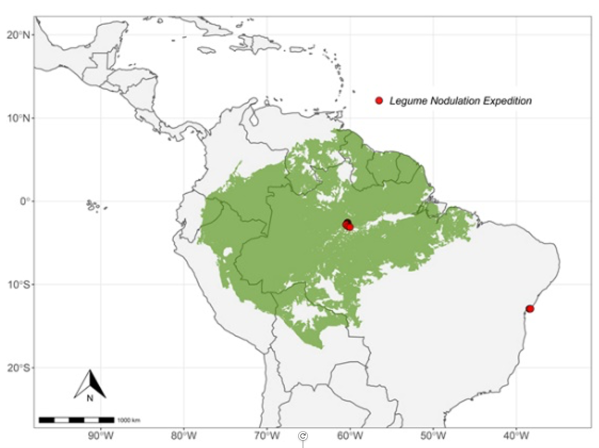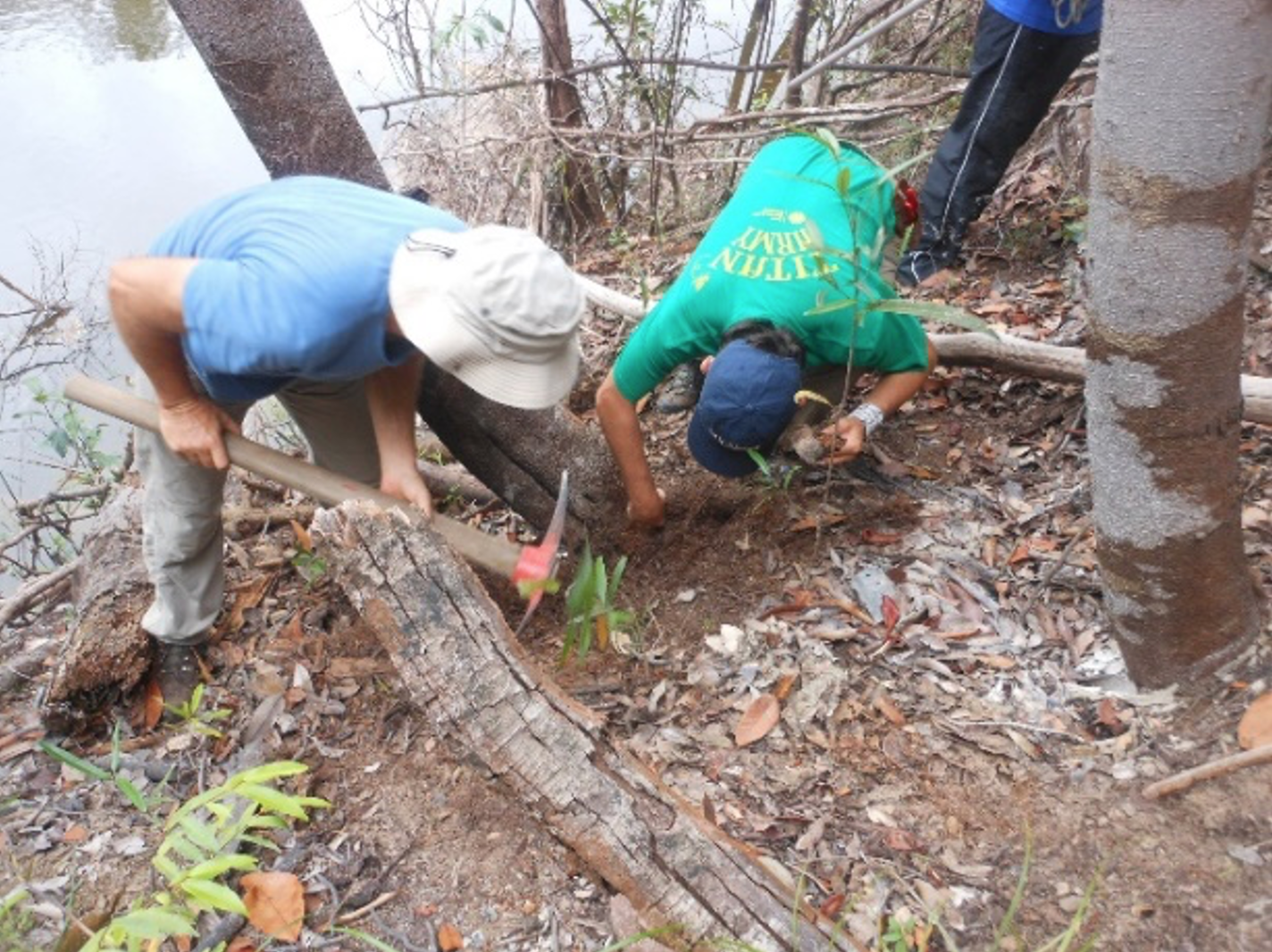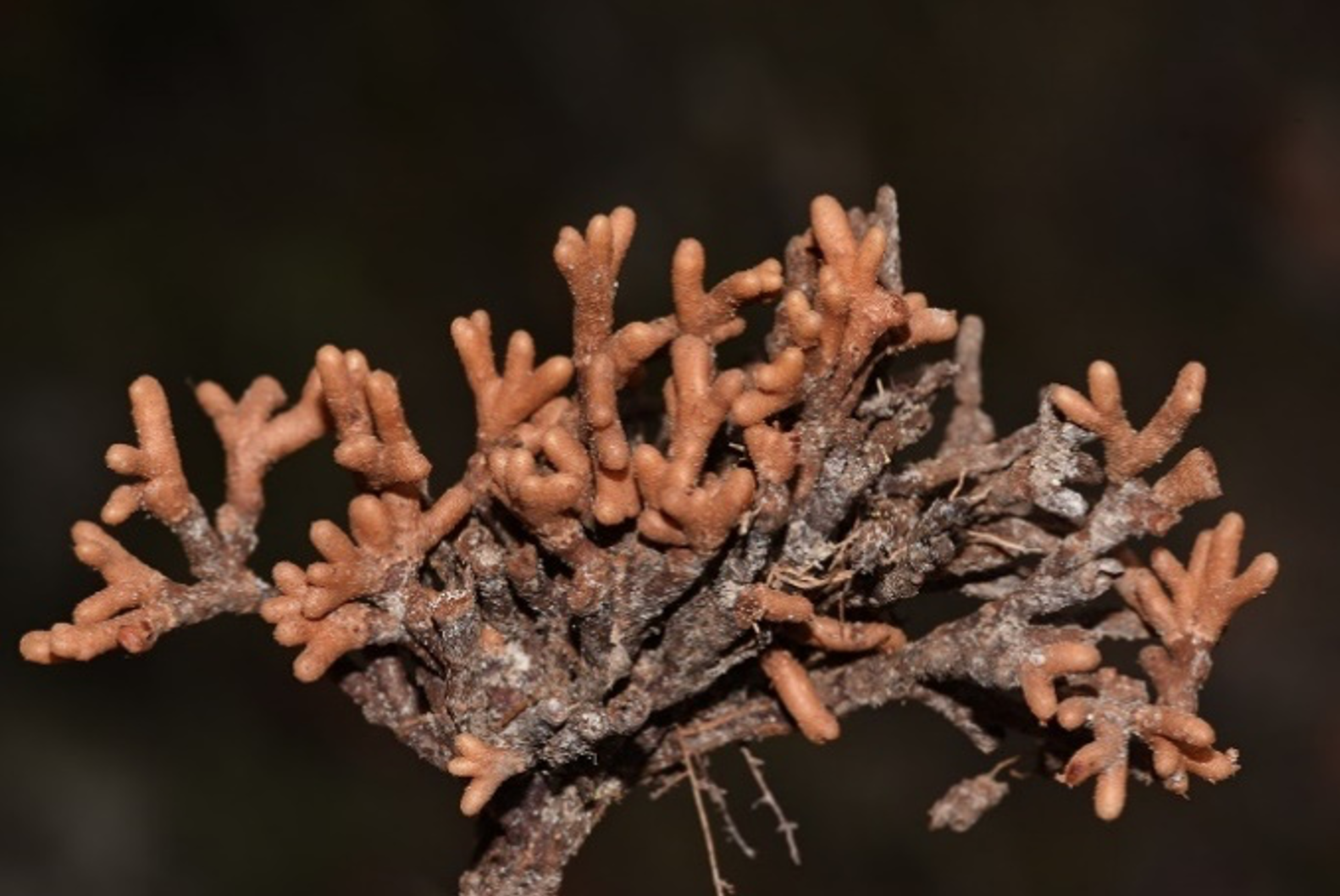Issue 67: From Amazon tree legumes to nitrogen-fixing maize: What’s the connection?
Euan K. James, Marta Maluk, and Janet I. Sprent
The James Hutton Institute, Invergowrie, Dundee DD2 5DA, UK
A team at the James Hutton Institute, Dundee, Scotland, forms part of a research consortium led from the Crop Science Centre, part of the Department of Plant Sciences Sainsbury Laboratory at the University of Cambridge, which is aiming to transfer the ability to form Nitrogen (N)-fixing nodules to non-legumes, especially cereals (https://www.ensa.ac.uk/). Nodulation is a process through which legume plants form a symbiosis with bacteria that live in the roots of the plants and take N from the atmosphere to convert it into compounds that the plant can use for its growth. In cereal crops like maize, wheat and rice, there is no capacity for making root nodules, and so these crops are dependent on farmers applying large quantities of fertiliser to obtain their nitrogen. Fertilisers are expensive and are now recognised as highly damaging in terms of pollution from nitrates in drinking water, as well as producing high greenhouse gas emissions that contribute to global warming. A major aim in biotechnology is to transfer the root nodulating ability of legumes to cereal crops so that they are no longer dependent on expensive and polluting nitrate fertilisers. The Engineering Nitrogen Symbiosis for Africa (ENSA) research project is specifically targeting maize as an important crop in sub-Saharan Africa for smallholder farmers who cannot afford fertiliser. However, the transfer of nodulation ability to maize is very complicated, because many genes are involved.
The Hutton team are involved in the Evolution of Nodulation sub-project within ENSA. This sub-project aims to understand how legumes were able to evolve and develop the ability to form nodulating symbioses with soil bacteria called rhizobia. By better understanding how nodulation evolved in legumes it is hoped to gain insights into whether this trait can be transferred to cereals. For example, it is known that most land plants, including cereals and legumes can form root symbioses with arbuscular mycorrhizal fungi (AMF), and the genetic/developmental pathway underpinning this symbiosis is common to all land plants that interact with AMF; this same pathway has been adopted and adapted by legumes (and a number of other plant lineages within the Rosid clade) to form N-fixing nodules (Radhakrishnan et al. 2020). Therefore, in theory it should be possible to engineer the AMF developmental pathway in other plant groups, such as cereals, to make N-fixing nodules.
Most, but not all, of the ca. 20,000 species of legumes are nodulated (Doyle 2016; Sprent et al. 2017). Nodulation is the “norm” in subfamily Papilionoideae (>97% nodulated), rare in non-mimosoid members of subfamily Caesalpinioideae sensu LPWG (2017) (c. 30% nodulated), but common in the mimosoid clade within this subfamily (>93% nodulated). Nodulation is absent in > 6,000 legume species, and has never been reliably reported in subfamilies Cercidoideae, Detarioideae, Dialioideae, and Duparquetioideae (Sprent et al. 2017). Recent work documenting the presence or absence of key genes for nodulation in fully-sequenced genomes of species within the N-fixing clade of the Rosids, including several legumes, suggested that nodulation was acquired once, but subsequently lost many times across this group, and that this explains the “patchy” occurrence of nodulation in the N-fixing clade sensu lato (Griesmann et al. 2018; Van Velzen et al. 2018). However, many questions remain about how and/or why nodulation has remained so widespread and stable in certain legume subfamilies/clades, but has been apparently so massively lost in others.
Against this background, the specific aims of the Hutton team within ENSA are to assemble an interactive database ILDON (International Legume Database of Nodulation) to catalogue all reliable reports of nodulation (both current and future) and to document the diversity of nodule structures across all legume genera and species using the latest legume taxonomy. The Hutton team is analysing wild and cultivated legumes to define precisely the nature of infection and nodule structure. They are specifically interested in identifying species that undertake “primitive” crack versus “advanced” root hair entry; centralised versus peripheral nodule vasculature; and “primitive” fixation threads versus “advanced” symbiosomes. Understanding the diversity and phylogenetic distribution of these nodule traits is fundamental for unlocking the potential for successful transfer of nodulation to non-fixing crops. An important aim is to identify legume genomes for sequencing that could be used to identify the genes underpinning these important nodulation traits.


As part of this work, in December 2019, a field expedition was conducted to the Brazilian Amazon to sample root nodules from legume trees. The Amazon region is globally one of the richest legume diversity hotspots and a centre for radiation of many legume genera, including a number of key “basal” genera in subfamilies Caesalpinioideae and Papilionoideae whose nodulation status and characteristics remain unknown. As such, the Amazon is a prime site for sampling taxa which can assist in our understanding of how nodulation evolved in legumes. The expedition concentrated around the Rio Cuieiras, a tributary of the Rio Negro (the northerly one of the 2 rivers that combine to make the Amazon “proper” at Manaus) (Fig. 1). December marks a period where increased precipitation and runoff from the Andes results in the Amazonian river level rising rapidly, so many of the forests were flooded or in the process of becoming flooded (Fig. 2).
Target legume genera and species were partly determined on the basis of enigmatic or incomplete reports of nodulation, but also on the availability of nodules on certain genera in the area covered by the expedition, which could only be determined by excavating their root systems. The sampled nodules are now being analysed, including DNA fingerprinting of the legume species, investigating nodule anatomy, rhizobial isolation and genome sequencing of selected isolates to determine the evolutionary history of their symbiosis genes (nod, nif).
Highlights of the expedition included:
- Absolute confirmation of nodulation by Jacqueshuberia, making it only the eighth non-mimosoid genus in subfamily Caesalpinioideae to be shown to be nodulated (Fig. 3, 4).
- Collections of nodules from other non-mimosoid Caesalpinioideae genera, such as Campsiandra, Moldenhawera, and Tachigali.
- Sampling of nodules from Pentaclethra macroloba an early-branching mimosoid.
- Sampling of enormous nodules from several individuals of the profusely-nodulated, early-branching papilionoid genus Swartzia (Fig. 5, 6).




We acknowledge the invaluable support and assistance of the Instituto Nacional de Pesquisas Amazônica (INPA), especially Charles Zartmann, without whom the expedition would not have been possible. In addition, we thank Domingos Cardoso (UFBA, Salvador, BA) and Haroldo de Lima (Jardim Botanico, Rio de Janeiro, RJ) for their botanical expertise, and Eduardo Gross (UESC, Ilheus, BA) for help with nodule sampling. The assistance and hospitality of communities in the Rio Cuieiras is also acknowledged. ENSA is sponsored through a grant to the University of Cambridge by the Bill & Melinda Gates Foundation and the UK government’s Foreign, Commonwealth and Development Office (FCDO).
References:
Doyle 2016. Chasing unicorns: Nodulation origins and the paradox of novelty. American Journal of Botany 103: 1865-1868. https://doi.org/10.3732/ajb.1600260
Griesmann et al. 2018. Phylogenomics reveals multiple losses of nitrogen-fixing root nodule symbiosis. Science 361: eaat1743. https://doi.org/10.1126/science.aat1743
LPWG 2017. A new subfamily classification of the Leguminosae based on a taxonomically comprehensive phylogeny. TAXON 66: 44-77. https://doi.org/10.12705/661.3
Radhakrishnan et al. 2020. An ancestral signalling pathway is conserved in intracellular symbioses-forming plant lineages. Nature Plants 6: 280-289. https://doi.org/10.1038/s41477-020-0613-7
Sprent et al. 2017. Biogeography of nodulated legumes and their nitrogen‐fixing symbionts. New Phytologist 215: 40-56. https://doi.org/10.1111/nph.14474
Van Velzen et al. 2018. A resurrected scenario: Single gain and massive loss of nitrogen-fixing nodulation. Trends in Plant Sciences 24: 49-57. https://doi.org/10.1016/j.tplants.2018.10.005